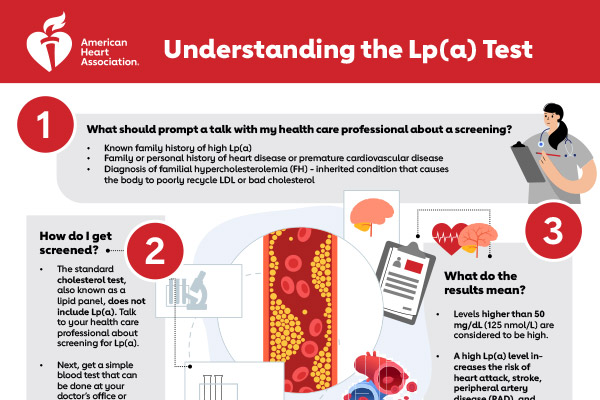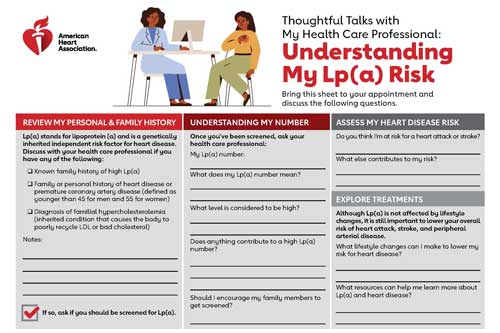Lipoprotein (a) Meaning and How Does it Impact My Heart Health?

Read this article in Spanish: ¿Qué es la Lp(a) y cómo afecta mi salud cardíaca? (PDF)
Committed to avoiding the heart disease that ran in her family, Sandra Revill Tremulis adopted a healthy lifestyle and prioritized annual preventive screenings. Despite maintaining normal cholesterol numbers, plaque built up on the walls of her arteries. At age 39, she almost died of a heart attack caused by a 95% blockage.
Further testing showed the likely problem; Tremulis had high numbers of lipoprotein(a), or Lp(a).
“That was the beginning of my education and my empowerment,” she said. “I just couldn't believe that people weren't talking about this.”
In the following years, she researched Lp(a), talked to health care professionals, and started a foundation to raise awareness of the condition. These efforts led to the Centers for Disease Control and Prevention (CDC) recognizing high Lp(a) numbers as a clinical diagnosis in 2018. They approved diagnosis codes for billing and payment related to clinical work and laboratory testing.
“I wanted to make sure that there's help for every child who inherits this so that they can change their cardiovascular destiny,” she said.
What’s Lp(a)?
Lp(a) is a genetically inherited lipoprotein and a common independent risk factor for heart disease. Lp(a) is made up of two major proteins: apolipoprotein(a) [apo(a)] and apolipoprotein B (apoB)-100. Although Lp(a) and low-density lipoprotein (LDL), or 'bad' cholesterol, both contain apoB particles, they are different lipoproteins with unique characteristics. Similar to Lp(a), high apoB numbers are associated with an increased risk of heart disease. Ask your doctor if ordering a lab test to measure your apoB numbers is right for you.
Why does Lp(a) increase my risk of heart disease?
High Lp(a) numbers of 50 mg/dL (125 nmols/L) or higher promote clotting and inflammation, significantly increasing risk of heart attack, stroke, aortic stenosis and peripheral artery disease. This is especially true for those with coronary heart disease or familial hypercholesterolemia, or FH, an inherited condition that affects the body’s ability to process LDL “bad” cholesterol.
Lp(a) can accumulate in the walls of blood vessels, forming plaques similarly to LDL cholesterol. These plaques can block blood flow to vital organs such as the heart, brain, kidneys, lungs, and other parts of the body, leading to conditions like heart attacks, strokes, and other cardiovascular diseases.
Recent preliminary studies have determined a possible connection between high Lp(a) numbers and the risk of calcific aortic valve disease (CAVD). High Lp(a) numbers increase inflammation and calcification in heart cells, leading to calcium buildup in the aortic valve.
How do I know if I am at risk for high Lp(a)?
Many people with high Lp(a) don’t experience symptoms, so it’s important to talk with your health care professional if you have any of the following:
- Family history of high Lp(a) or early development of heart disease.
- Familial hypercholesterolemia (FH), about a third of people with the condition also have high Lp(a) numbers.
- Personal history of heart attack, stroke, or coronary artery disease before age 55 in men or age 65 in women.
- Poor circulation in your legs because of peripheral arterial disease.
- Diagnosis of aortic stenosis, a narrowing of the valve between the heart’s lower left chamber and the aorta artery.
Does my ethnicity or any other factors put me at a higher risk for high Lp(a)?
While high Lp(a) numbers occur in people of all races, South Asian and Black people of African descent have the highest numbers. People with FH and kidney disease are also more likely to have high Lp(a) numbers. Women aged 50 and older have also been shown to have higher Lp(a) numbers than men.
How do I get my Lp(a) tested?
Talk with your health care professional, especially if you have a family or personal history of heart disease. While Lp(a) isn’t included in most cholesterol tests, your doctor can order a separate blood test that measures Lp(a).
How do I lower my Lp(a)?
While lifestyle changes don’t affect your Lp(a) numbers, doctors recommend people with high Lp(a) stay active, eat a healthy diet, get enough sleep, avoid smoking, and maintain a healthy body mass index, or BMI.
“Life’s Essential 8 are the key measures for improving and maintaining cardiovascular health (as defined by the American Heart Association),” Reyes-Soffer said.
It’s also important to stay on top of your cholesterol, said Reyes-Soffer, noting that having high numbers of LDL and Lp(a) may further increase your risk of heart disease.
Lipoprotein apheresis is a recommended treatment option for eligible familial hypercholesterolemia patients with high numbers of both LDL and Lp(a). This procedure involves filtering out both Lp(a) and LDL, temporarily lowering their numbers. Ask your health care professional about appropriate treatment options for you.
Looking ahead
“New treatments to lower Lp(a) levels are in the works and could hit the market as soon as 2025”, Reyes-Soffer said.
Reyes-Soffer said she supports the Centers for Disease Control and Prevention’s efforts to develop national standards around the levels of Lp(a) that increase risk and whether that varies from person to person, by ethnicity or other factors.
“Having the standardization of the assays so that we can ascertain the levels that place individuals at risk and who will benefit from new drugs is very important,” she said. “Knowledge is power.”








